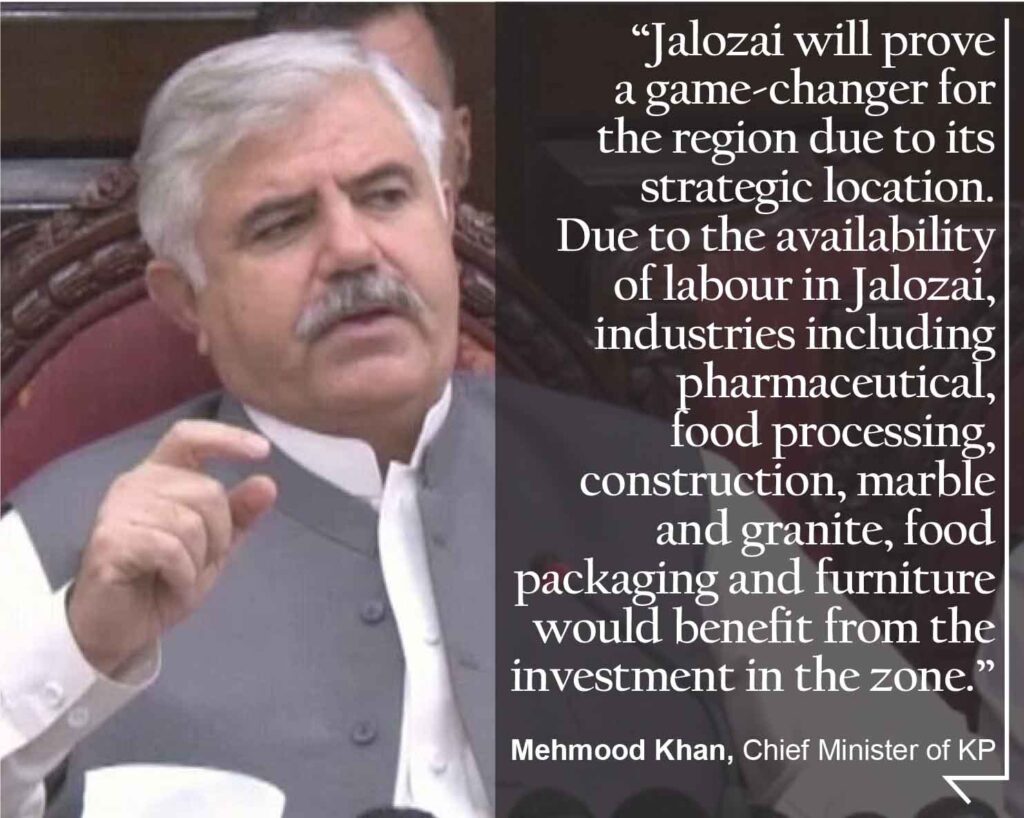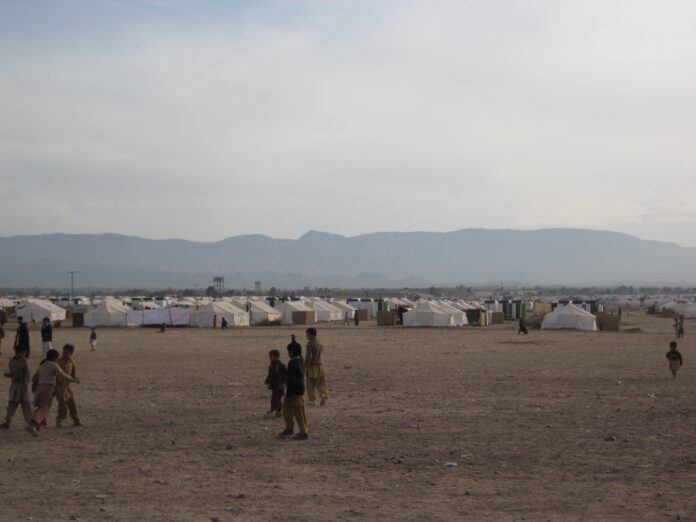At the beginning of the millennium, the world was at the precipice of a new era. The Berlin Wall had fallen, Thatcher and Reagan had faded into the shadows, the Cold War was over, and the Soviet Union was defeated. Then, the catastrophic tragedy of 9/11 happened, launching the world into the War on Terror.
Pakistan was quick to join America in this war, and one of its major frontiers would be Pakistan’s Western neighbour, Afghanistan. But even as a new world was emerging from the ashes of 9/11, a dark reminder of another alliance between Pakistan and the United States still loomed in all of its squalid misery.
Almost 7,000 miles away from New York, where the World Trade Center buildings had been attacked on September 11, the Jalozai refugee camp was still housing thousands of Afghan refugees from a different misadventure between Pakistan and the USA in Afghanistan.
The Jalozai refugee camp was at one point home to 80,000 Afghan refugees fleeing from the 1979 Soviet invasion of Afghanistan. Over the decades, it became famous for the putrid conditions its inhabitants had to suffer. Today, four decades after it was first set up, it is set to become Khyber-Pakhtunkhwa’s second largest housing scheme, stretched over approximately 1,200 acres. Where once lay a city of tents and prison-like conditions, tomorrow there will be houses with running water, electricity, and all the trappings of modern life.
This radical transformation for a place that was once dubbed Pakistan’s ‘living cemetery’ marks the lifting of a great, dark shadow. It is a partial shunning of the shackles as Pakistan continues to come out of the War on Terror. How has the fate of Jalozai come to this? And what plans does the provincial government have for this place that has had a storied yet tortured past? Profit, investigates the history and prospects of the up and coming Jalozi housing scheme.
A fraught history
In February 2002, the United Nations High Commissioner for Refugees (UNHCR) celebrated the closure of the notorious Jalozai refugee camp. The departure of the last 1,570 refugees to other camps located close to the border between Pakistan and Afghanistan marked what should have been an end to decades of the camp’s despondent living conditions.
To understand the conditions at Jalozai, one has to understand the sheer volume of people that had been fit into a small amount of space. When the Soviets invaded Afghanistan, a flood of 2 million refugees entered Pakistan. More than 150 refugee settlements were established, and the biggest of these was Jalozai, which housed 80,000 people at its peak.
Only 40 kilometres away from Peshawar, the space of the Jalozai camp was simply too small for the amount of people that were packed into it. According to a report of the UNHCR senior emergency officer, Mohammed Ader, people were crammed together and “there was simply not enough space to dig the latrines that were required and to put in the shelters that were necessary.”

The experience for the hundreds of thousands of Afghans that lived in the camps was bitter. It was overcrowded, filled with make-shift tents, no water or sanitation and no firebreaks. These conditions were serious risks for the spread of infectious diseases such as meningitis, measles and tuberculosis.
But over the years, because of how Pakistan treated refugees, Jalozai became a hellish stopover. According to Doctors Without Borders, which was the only NGO to be operating in the camp, the history of Jalozai and the fate of its population have been controversial issues.
In the 1980s, people coming to the camp were fleeing the Soviets, but as the Taliban seized the vacuum in the 1990s and began to consolidate, Afghans began to flee from them. As the earlier mentioned Doctors Without Borders report mentions, up until 1998, Pakistan granted asylum to them on a prima facie basis, meaning the entire group was considered refugees without giving individuals refugee status. That changed in 1998 when Pakistan no longer considered new arrivals as genuine refugees. However drought and ongoing conflict caused an ongoing influx of Afghans seeking refuge in Pakistan.
While in other locations such as Shamshatoo a whole system was being set up with food distribution, health care and education, Jalozai was neglected, despite a rapidly rising population lacking any assistance, let alone refugee status. ‘Deplorable and inhumane’, were words describing the situation inside Jalozai.
Later on, after the events of September 11, there was another influx of refugees. While the UNHCR celebrated the closure of the camp in February 2002, Jalozai remained a sore spot for years to come. Resentment among refugees meant that there were many there indoctrinated by the Taliban. The camp partially turned into a hideout for militants, and was under attacks as recently as 2014.
Now, after years of relative stability and freedom from terror attacks, Jalozai is ready to become a modern economic zone, and with that comes a fully equipped housing society. The transformation of Jalozai from a horrendous camp of nearly 100,000 to a housing society is an important and sure step towards coming out of the shadow of the War on Terror. But given the delicacy of the area, how is the government dealing with this change?
Special economic zone
In July this year, as the coronavirus pandemic was at its peak in Pakistan, KP Chief Minister Mehmood Khan broke ground on the Jalozai Special Economic Zone in the Nowshera District. There is a recent detailed feature on SEZs and how they work by Profit, which explains what Jalazoi being turned into an SEZ effectively means.
It is also worth mulling the shift in times we are seeing. If the coronavirus pandemic had happened even 10 years ago, Jalozai would have been a major virus epicenter. The horrendous camp had been so cramped it was an epicenter of diseases much less infectious and more easily manageable than the coronavirus. Now, however, Jalozai is a place for which the KP government has high hopes.
A statement from the Chief Minister says that the zone’s development by the KP Economic Zones Development and Management Company over 257 acres of land is likely to generate 50,000 direct and indirect jobs, attract Rs6 billion investment, and is testament to the rapid industrialization of KP.
“Jalozai will prove a game-changer for the region due to its strategic location,” he said. “due to the availability of labour in Jalozai, industries including pharmaceutical, food processing, construction, marble and granite, food packaging and furniture would benefit from the investment in the zone.”

Along with this dream for economic development and prosperity for Jalozai, come practical needs as well. Chief among them are living solutions for the 50,000 people that will find themselves employed thanks to this SEZ. For this, a housing society is being set up, with the ensured provision of all necessary utilities to the zone, including 5 to 10MW power from the 132KV grid through 11KV.
From abject camp to fully loaded housing
As an SEZ, Jalozai has different rules. It also means that the government is doing everything it possibly can to attract investment and increase ease of doing business. Part of this process includes making sure that skilled workers are on hand and regularly available. The best way to do this is by providing them with quality accommodations, which means that the Jalozai housing society is not going to be a money making endeavour for the provincial government.
KP Housing Minister, Dr Amjad Ali, said that the Provincial Housing Authority (PHA) was working to further extend the land area of Jalozai housing scheme by 5000 kanals of land. According to him, the PHA y has approved the acquisition of additional area through land sharing basis. Under this scheme, the owner of the land would get one Kanal developed plot for handing over four kanals to the housing authority. In addition to this, the landowners will pay Rs 1.2 million as development charges. These kinds of expansions were never attempted whe Jalozai was only a campy, but now after this scheme, the price of one Kanal of land in Jalozai housing scheme is around 3 million rupees. This way, the housing scheme will expand and local landowners will also get a profitable share.
“Over 70 percent of the plots in the Jalozai housing scheme have been allotted to government servants in three year instalment plan. At least 90 percent of the construction work on the scheme from block A to E has been completed, and the possession letters to the allottees of Phase 1 would be awarded in December 2020, after which the owners could start the construction work on their houses,” says Dr Amjad Ali.
“A dedicated grid station would be established for the housing scheme, on which the Peshawar Electric Supply Company (PESCO) would start physical soon. PESCO, until the establishment of the grid station, will provide powers through dedicated feeders on a transition basis. Part one of this project requires the spending of Rs14 billion.”
These kinds of arrangements were not even a dream back when Jalozai was still a camp. Now, the housing society being planned in this space is being built on a large model along the lines of gated communities in urban areas. Most of the land being acquired for expansion will not in fact be used for residential purposes, but instead for roads, parks, and other recreational purposes that will make the housing society top of the line.
“We have also allocated space for commercial purposes in the scheme, which would soon be advertised. Residents will be able to avail the facility of private schools, colleges and healthcare facilities in the premises,” said Dr Ali.
“The PHA is also going to construct around 20,000 grey structures in Peshawar Residencia housing scheme under the Naya Pakistan Housing Programme. The houses units will be constructed in collaboration with Pakistan housing foundation in Sarozai area of Peshawar,” he goes on to say. He explains that the Pakistan housing foundation was the implementing partner in the scheme, and responsible for the construction of the grey structures. He said the balloting process for the housing scheme has already been completed, and a consultant has been selected. He added the total cost of the project was 97 billion rupees.
“Approval has already been sought from the PDWP for construction of boundary wall, main gate and check posts for the scheme. This is all for ease of access. The PHA was not a profit earning enterprise, and its prime focus was to provide shelter to low income strata in the province on no profit no loss basis,” said Dr Ali. He went on to say that the provincial government has also signed an MOU with Federal Government Employees Housing Authority (FGEHA), under which the PHA would construct 20 plus floors High rise residential apartments in Nishtarabad area of Peshawar. He said the high-rise building would be constructed on 36 Kanal of land on the model of Centaurus Islamabad, which would also include commercial spaces apart from residential apartments. He said a total of 15bn rupees would be spent on the project.

The housing department has also started several schemes for the government servants in the province. The PHA was constructing high-rise flats for the government sector in Phase five Hayatabad, on which more than 80 percent of construction work has been completed. He said two blocks, B and E, of the high rise flats would be completed by October this year. Similarly, work on civil quarter flats would also be initiated soon. He added, the department has also launched the Hangu Township project for general public and government servants, for which the registration process was underway.
“In addition to mega housing schemes in the province, the government was also focusing on development of satellite towns in various areas of the province. The Mulazai housing scheme in Peshawar has been completed and soon the allottees would start construction work on their houses.” Similarly, he said the PHA has also completed 350 Kanal Hevelian housing schemes. He said work on Swat housing scheme in Dangram would also be started soon, in which 50 Kanal of land has been allocated for the media colony. He said potential sites have been identified for the establishment of satellite towns in various areas of the province, which includes Peshawar, Kohat, Khyber, Swat, Malakand among others. He said consultants would be hired after issuance of section four.










Please can you send me all information phajalozi scheme thank you
The Hash Mall, is emerging as one of the leading & prominent projects in Bahria Town that is grabbing the attention of local & foreign investors. An iconic project of its kind that has brought emulative investment opportunities for the investors who are willing to make a profitable & secure investment. The Hash Mall is the region’s premier family-oriented Shopping Mall, Dine-in & entertainment hub to enhance the living standard of the people. This elite project is quite an attraction & will add value to the heart of Bahria.